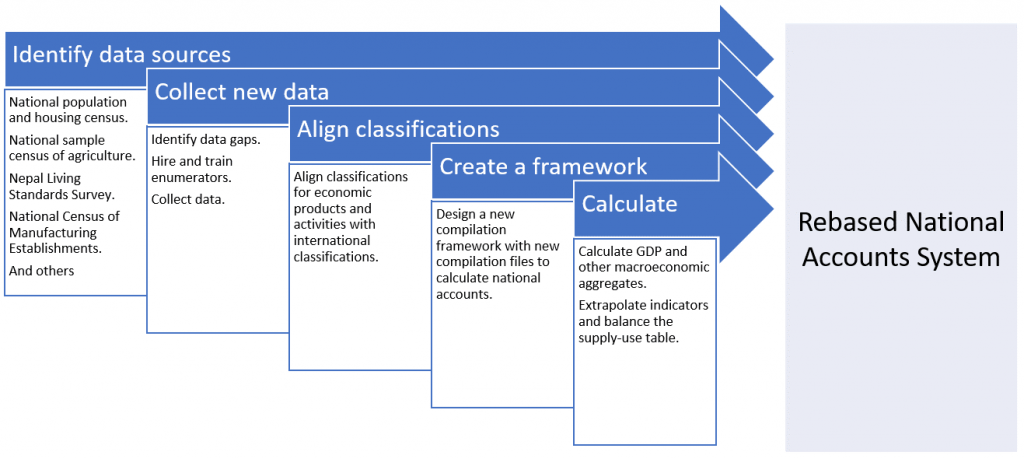On March 4, 2021, the Central Bureau of Statistics of Nepal (CBS) released a new, revamped series of estimates for its Gross Domestic Product (GDP). Data quality improvements reflect a comprehensive “rebasing” exercise for Nepal’s national accounts to overhaul measures of economic activity, supported by technical assistance from the World Bank. International standards recommend these rebasing processes be undertaken regularly, to reflect the most complete and accurate data sources available, update estimation methods and align with the latest international concepts and standards.
Establishing a periodic benchmark year via a rebasing exercise helps ensure a country’s economic structure is accurately measured. Along with other elements in the standard national accounts framework, this statistical overhaul is achieved through a supply and use table, a comprehensive, balanced matrix of economic activity, ensuring all available information sources are jointly assessed and integrated into GDP calculations. New statistics compiled in this rebasing process serve as a baseline for more timely GDP estimates in real terms (constant prices), improving the accuracy of measures of the volume of activity and economic growth.
Rebasing the national accounts in Nepal
Rebasing refers to a process of updating base-period benchmarks with new updated statistics and in line with international best compilation practice, to arrive at a new economic structure that will serve as the basis for estimating gross domestic product and its components moving forward. While many countries undertake rebasing processes more frequently, in Nepal there is generally a 10-year span between these comprehensive structural updates. In 2017, with technical assistance from the World Bank, Nepal embarked on an exercise to update the base period from fiscal year (FY) 2001 to FY2011, which was chosen for two main reasons: first, there were no significant (economic, political, or other) shocks in that year, ensuring the resulting structure is representative moving forward (Nepal suffered an earthquake in 2015 and an external shock caused by the trade blockade in 2016). Second, the best coverage of statistical data from surveys, censuses, and special studies was achieved in FY2011. In that year, the share of the economy covered by available data sources was at its highest (around 70 percent in GDP terms), relative to more recent periods that were also considered as possible base years.
The Bank’s support to Nepal involved two key activities, among others: an update of data sources and national accounts compilation standards and the implementation of supporting tools for a standardized process for national accounts compilation. Activities were implemented in several technical assistance missions and workshops conducted over the period from 2017 to 2019. While the rebasing was completed in 2019, the outbreak of the COVID 19 pandemic and subsequent factors resulted in inevitable delays in its official publication.
The diagram below illustrates the components and stages included in Nepal’s rebasing process.
Fig 1. Illustration of Nepal's rebasing process

The impact of quality improvements for Nepal
The new national accounts series include important recommendations of the latest international standards for the System of National Accounts (SNA 2008) that apply to the Nepali economy[1], unlike the former series compiled using the previous (SNA 1993) standard. As a result of the rebasing, the value of Nepal’s Gross Domestic Product (GDP) was revised upwards by 14.1 percent. This upward revision reflected better coverage in most industries, in particular services like wholesale and retail trade, financial and insurance activities, and real estate and profession activities. Overall economic growth for the period since FY2011 was not revised substantially.
Next steps
Now that the rebasing of Nepal’s national accounts is completed and published, the World Bank looks forward to supporting the CBS in a range of subsequent improvements. Examples include back-casting to ensure historical continuity in the time series, new quarterly national accounts measures and “chain-linked” volume measures and institutional sector accounts, along with strengthened ongoing statistical practices and policies. All these efforts contribute to meaningful, strengthened measures to gauge the evolution of Nepal’s economy, building capacity to inform evidence-based policy choices.
[1] Including the calculation of work-in-progress in agriculture, the measurement of financial intermediation and insurance services and the treatment of pensions, among others





Join the Conversation